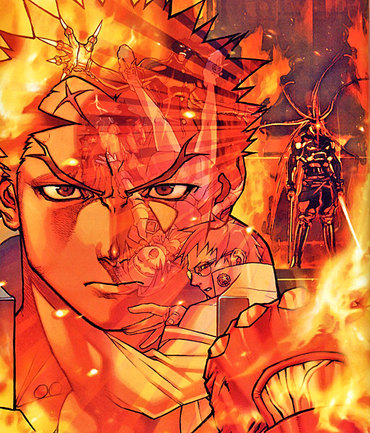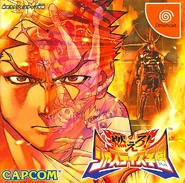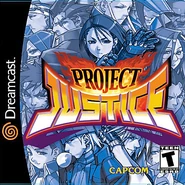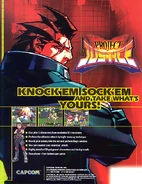(Adding categories) |
|||
| Line 80: | Line 80: | ||
[[Category:Games]] |
[[Category:Games]] |
||
[[Category:Fighting Games]] |
[[Category:Fighting Games]] |
||
| + | [[Category:Arcade Games]] |
||
Revision as of 16:29, 26 January 2011
Project Justice (Japanese: 燃えろ!ジャスティス学園 Moero! Justice Gakuen; translation: Burn! Justice Academy) is the 2000 sequel to the fighting game Rival Schools: United By Fate.thumb|300px|right|Intro In Europe, Australia, and Latin America, this game is known as Project Justice: Rival Schools 2. The following year, the game was ported to the SEGA Dreamcast.
The schools involved and the characters

Japanese Cover Art
Taiyo High School
- Batsu Ichimonji/Burning Batsu - (Burning version must be unlocked)
- Hinata Wakaba
- Kyosuke Kagami
- Chairperson
- Ran Hibiki
- Hayato Nekketsu
Gorin High School
Gorin University
Pacific High School
- Boman Delgado
- Roy Bromwell - (must be unlocked)
- Tiffany Lords - (must be unlocked)
Gedo High School
- Daigo Kazama/Wild Daigo - (Wild version must be unlocked)
- Eiji "Edge" Yamada
- Gan Isurugi
- Powered Akira - (must be unlocked)
Seijyun High School
Justice High School
- Hideo Shimazu
- Hyo Imawano/Demon Hyo - (both versions must be unlocked)
- Kurow Kirishima/"Vatsu" - (both versions must be unlocked)
- Kyoko Minazuki
Darkside Student Congress - (unlockable alternate storyline)
Style and gameplay
As in the original game, the combat in Project Justice is very tongue-in-cheek. Many of the characters use their chosen field of academic or sporting excellence as a fighting style (e.g. Soccer, Swimming, Music, Physiotherapy) and, as a result, special moves - in particular the Two-Person team-up moves - tend to have a surreal edge, with methods to injure your opponent ranging from: forcing them to take part in an impromptu bout of synchronised swimming (on dry land); confusing them by taking photographs of them in rapid succession during an interview for the school newspaper, or even berating them so severely that they fall unconscious out of shame.
From its predecessor, which allows the player to select two characters, Project Justice allows the player to select three characters to form a team. Due to this, the player can do two different Team-Ups, and the Party-Up technique, which has all three characters execute an attack to the opponent. As in Rival Schools: United By Fate, the Team-Up technique costs two levels of Guts in the Guts meter, which was cut down to five levels from nine. Also, the player is given a chance to cancel an opponent's Team-Up attempt by means of a Team-Up cancel, wherein a 5-second fighting sequence takes place. If the player scores a blow on the opponent, the opponent's Team-Up technique is cancelled. If not (or if the time runs out), the opponent's Team-Up technique will continue. The Party-Up technique uses all five levels of the Guts Meter, and cannot be cancelled once the initiating blow connects.
Plot
Project Justice's single player mode was structured differently from its predecessor. While Rival Schools: United By Fate plays a story only if characters from the same school were selected, the game instead has separate Story and Free modes.
- In Story Mode, players select a portion of story grouped by school and play through a rigid storyline with a limited group of 2 to 6 characters that the player can choose from for each fight. Like the original game, each fight in story mode is accompanied by traditional 2-D animated cut-scenes that advance the story. In some stories, the plot will branch out depending on the results of certain fights or decisions made by the player, changing the fights that the player will face. After confronting the boss of the game, an ending for the school's story is shown.
- In Free Mode, players select a team of three characters and fight random teams of opponents until getting to fight the boss, similar to selecting two characters from different schools in Rival Schools: United By Fate. After defeating the boss, the player is shown a screen where the game rates the player's performance, and gives them a ranking named after a character from the game.






